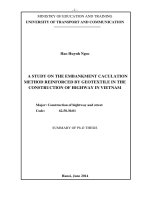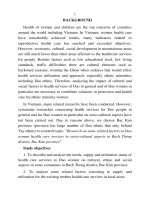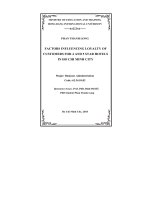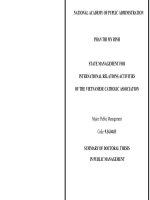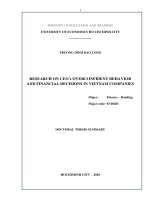Doctoral thesis summary study on rice breeding for brown planthopper resistance using molecular markers
Bạn đang xem bản rút gọn của tài liệu. Xem và tải ngay bản đầy đủ của tài liệu tại đây (2.13 MB, 28 trang )
MINISTRY OF EDUCATION
AND TRAINING
MINISTRY OF AGRICULTURE
AND RURAL DEVELOPMENT
VIETNAM ACADEMY OF AGRICULTURAL SCIENCES
*******
PHUNG TON QUYEN
STUDY ON RICE BREEDING FOR BROWN
PLANTHOPPER RESISTANCE USING
MOLECULAR MARKERS
Major Field: Genetics and Plant Breeding
Code: 62.62.01.11
DOCTORAL THESIS SUMMARY
Hanoi - 2014
The Doctoral thesis was completed in:
AGRICULTURAL GENETICS INSTITUTE
Scientific Supervisors:
1: Assoc. Prof. Vu Duc Quang
2: Dr. Luu Thi Ngoc Huyen
Reviewer 1:
Reviewer 2:
Reviewer 3:
The Doctoral thesis was defended at Institute Committee of PhD Dissertation
Examination:
………...…………………………………………………………………………………
………………………………………………………………………….....……………..
Date:
The Ph.D thesis may be found at: .....................……………………………………..
THE PUBLISHED ARTICLES RELATED TO THE CURRENT THESIS
1 Phung Ton Quyen, Nguyen Thi Lang, Luu Thi Ngoc Huyen, Vu Duc
Quang (2010), “Evaluation of some brown planthopper resistance of rice
lines/varieties in Red River and Cuulong deltas”, Journal of Vietnam Science
and Agricultural Technology, No: 1 (14)/2010, pp. 8-13 (in Vietnamese)
2 Dinh Van Thanh, Lai Tien Dung, Phan Thi Bich Thu, Luu Thi Ngoc
Huyen, Phung Ton Quyen (2011), “Results of evaluating research on brown
planthopper resistance Nilaparvata lugens (Homoptera: Delphacidea)”, Final
Report of Department of Crops Production, Agricultural Publisher, pp. 256-263
(in Vietnamese).
3. Luu Thi Ngoc Huyen, Phung Ton Quyen, Vu Duc Quang (2013),
“Application of marker technology to develop inbred rice with brown
planthopper resistance”, Journal of Vietnam Science and Agricultural
Technology, No:2 (41)/2013, pp. 20-25 (in Vietnamese).
INTRODUCTION
1. Imperativeness of the dissertation
Rice (Oryza sativa L) is an important plant in Vietnam and is a major
food source for half of worldwide population. One of the feasible
strategies is to apply biotechnologies to improve rice yield and generate
new rice varieties to ensure the food demand of human.
Brown Planthopper (Nilaparvata Lugens Stal) is one of serious pests
which causes rice yield significant reduction in the rice producing
countries, especially in the tropic areas of rice growing in the world. In
Vietnam, approximately 10% to 30% out of total rice production are
annually loss due to planthopper.
The aim of applying marker assisted selection (MAS) is to use the
markers which are linked with the desire QTL/gen to enhance selecting
efficiency and shorten the selection time. To develop the rice varieties which
are resistant with brown planthopper with MAS, mainly depends on the markers
have linkage with the brown planthopper resistant gen is possible work. Hence,
we have concentrated on the topic entitled “Study on rice breeding for brown
planthopper resistance using molecular markers ”
Objectives of the dissertation
Applying marker assisted selection method to develop inbred-elite rice
varieties which shown a stability of brown planthopper resistance in the
Red River Delta areas.
2. Time and areas implementation
- From 2007 to 2013
- Agricultural Genetics Institute, Institution of Plant Protection, Center of
Technologies Exchange and Extension, Thanh Tri- Ha Noi.
- Field works was mainly conducted in Nam Dinh, Thai Binh, Ha Nam,
Hanoi, provinces.
3. Inovative and its contributions
1
- This is one of initial researches on improving rice planthopper
resistance by applying molecular breeding in Vietnam, it is also one of
part involving to Agricultural Biotechnology Project of MARD
- Within of the current dissertation, it has been successfully pyramided
two genes (planthopper resistant genes) into one rice variety by use of
SSR markers which linked to planthopper resistant genes.
4. Significant contributions
-Scientific significance: Application molecular markes to generate two
rice lines carrying two planthopper resistance genes
- Practical significance: The improved line KR8 is a promising line which
is possibly released for producing in a large scale.
6. Structure of Dissertation
The dissertation was presented in 155 pages which included: Introduction 3
pages, Chapter 1: Background and Scientific Basic (51 pages); Chapter 2:
Materials and Methods (23 pages); Chapter 3: Results and Discussion (57
pages), included 01 page presented for conclusions and suggestion, and 01
page listed the published article involving the current dissertation result, and
reference list (19 pages). Also, the dissertation included 37 Figures, 37
Tables and 167 liturature cited, in which there are 46 Vietnamese research
lituratures and 121 English research articles were used, 03 published articles
from the current dissertation and 2 appendixes.
Chapter 1
OVERVIEWS
1.1. Brown planthopper and its resistant characterization in rice
1.1.1. Bio-charateristics of BPH
The Brown planthopper (BPH) is among the most important pests of rice
which has a scientific name as Nilaparvata lugens Stal.
1.1.2. The status of rice losses have caused by BPH in recent years in Vietnam
2
BPH infestation has occurred in recent years, especially in 2000, over
540 thousand hectares of rice were infected by BPH, of which 256 thousand
hectares were seriously losses.
1.1.3. Characteristics of BPH resistance in rice:
1.1.3.1. Mechanism of pest resistance
The pests and insects were become harmful pests when agricultureintensive farming was initially conducted by human.
1.1.3.2. Genetics of BPH rice resistance
In the great efforts of research on BPH resistance in rice, some major
BPH resistant genes in rice have been identified and reported as the listed in the
Table 1.1
Table 1.1. BPH resistant genes and the rice varieties (indicator) carrying
the resistant genes
Indicator lines
TN1
Mudgo
ASD7
Rathu Heenati
Babawee
ARC10550
Swarnalata
T12
Chinsaba
Pokkali
O. australiensis
O. officinalis
O. officinalis
O. officinalis
O. officinalis,
O. australiensis,.
Rathu Heenati
O. australiensis
O. rufipogon Griff
AS20-1
O. minuta
O. minuta
Resistant gene
None
Bph1
bph2
Bph3
bph4
bph5
Bph6
bph7
bph8
Bph9
Bph10
bph11(t)
bph12(t)
Bph6, Bph13
Bph14 và Bph15
Bph16
Bph17
Bph18
bph18(t)
bph19
Bph20, Bph21
Bph20(t) và Bph21(t)
3
D/R
D
R
D
R
R
D
R
R
D
D
R
R
D
-
O. rufipogon Griff
O. eichingeri,
O. latifolia
O. officinalis
Oryza rufipogon Griff
Oryza sativa L
Tổ hợp lai TN1xGC9,
IS (IR72 x GC9)
bph22(t) và bph23(t)
Bph25
Bph25(t)
Bph 26
Bph26(t)
Bph27
Bph27 (t)
BphZ
Bph3+BphZ.
D
-
Note: D: Dominance; R: Recessive; (-) Unknown
1.2. Some biotechnology applications in genetic research and rice breeding
- Marker assisted selection (MAS)
MAS for single trait: The QTL/gen is transferred into elite variety by
applying Marker assisted backcrossing (MABC)
- Pyramiding 1-2 BPH resistant genes into some elite rice varieties
F1
F2
BC1F1
BC2F1
F3
BC3F1
Fn
BC4F2BC4F4
BC4F1
Figure 1. Diagram of applying molecular marker to select the rice lines
with BHP resistance (Huyen et al., 2011)
4
1.3. Genetic researches and selecting BPH resistant rice varieties in Vietnam
1.3.1. Identifying the molecular markers linked with the genes and
mapping the resistant genes in Vietnam
Some molecular markers have linkage with the BPH resistant genes have
been identified. Constructing a linkage map for BPH resistant gene (BphZ(t)) on
the chromosome 4, pyramiding the resistant genes Bph3+BphZ(t) and have
developed the potential BHP resistant lines namely IS1.2, IS2.3, RS. BphZ(t)
gene is being further fine mapped on the chromosome 4.
1.3.2. Improving the BHP resistant rice variety in Vietnam
In recent years, the CR203 and CR84-1 were known as medium BPH
resistant varieties, however, they were also affected when BPH infestation
severely occurred.
Chapter 2
MATERIALS AND METHODS
2.1. Materials
- BPH resistant rice varieties/lines were used as the donor plants: Two
BPH resistant genes Bph3 and BphZ(t) have been pyramided in these lines.
- The recipient plant: IR64 (Tam Dien Bien)
- SSR markers linked with Bph3 and BphZ(t) .
- The BPH resistant rice variety: Ptb33;
- The sensitive BPH: TN1
- The controlled variety: KD18
The origin of plant materials:
Rice variety/line carrying BPH resistant gene (donor plant)
The lines IS1.2, IS2.3 and RS were already pyramided 2 BPH resistant
genes Bph3 and BphZ(t), respectively. Based on the Bph3 mapping on the
chromosome 6 and BphZ(t) on the chromosome 4, the molecular markers (SSR)
which have linked with the genes were selected rầy nâu.
5
NST số 4 ë lóa Bản đồ LK gen BphZ(t)
Figure 2.1. Bph3 mapping in detail
Figure 2.2. BphZ(t) mapping in detail
(Huyen et al, 2003; 2010)
The recipient plant: IR64 variety
- BPH pests were collected in the Red River Delta and Thap Muoi areas
were used in this study.
- Chemical agents and other materials were purchased from GenSet,
Pharmacia, Sigma, Boehringer, Promega, BioRad, ...
2.2. Methods
2.2.1. Evaluation on BPH resistance and BPH sensitive of the rice
varieties/lines
Based on the rank standard of IRRI (5 ranks) and Institute of Plant
Protection (10 rank)
2.2.2. Backcrossing, pyramiding BPH resistant genes from the donors to
the elite rice variety
The parental plants included the donor (carrying BPH resistant genes) and
the donor without BPH resistant gene, but has some economic traits.
2.2.3. Information collection of molecular markers.
6
Most of molecular markers used in this study were collected from the web
and some other publications
2.2.4. Method to improve rice BPH resistance by molecular markers
techniques
- Evaluating and selecting the F2 to F6 generations on the field test
- Using SSR markers to identify BPH resistant gene
- Testing and confirming the BPH resistant lines which carried the BPH
resistant genes in the net house and the field test.
2.2.5. Other laboratory techniques
- DNA extraction, and purification following the CTAB method
- PCR techniques:
2.2.6. Field test
The experiments on the field were conducted by Thanh (1986).
2.3. Statistical and data analysis
IRRISTART 5.0, Excel 2007 were used in this study. Graphical Genotyper
2 (GGT2.0) and methods of statistical analysis another.
Chapter 3
RESULTS AND DISCUSSION
3.1. Evaluating the rice germplasm and the BPH resistant lines/varieties
.1.1. Results of some rice lines/varieties in 2008
Table 3.1. The effects of some rice varieties on the BPH in the Red River
Delta and Cuu Long Delta
1
CR203
Resistant
gene
1
2
CR84-1
1
NN
NN
3
Khang dan 18
None
N
NN
4
Q5
None
N
NN
5
SL12
None
NN
NN
No
Name
7
BPH test on
RRD
BPH test on
CLD
NV
NN
6
SL15
None
N
NN
7
IR64
None
NV
N
The rice lines carrying BPH resistant genes
8
IS1.2
2
KC
KC
9
IS2.3
2
KC
KC
10
RS
2
KC
KC
11
IS4.8
2
KC
KC
12
RS3
2
KC
KC
13
RS4
2
KC
KC
Controlled varieties
14
TN1
Sensitive
NN
NN
15
Ptb33
Resistant
KC
KC
Note: High resistance (KC), lightly infected (NV); infected (N), severe
infection (NN).
All lines IS and RS carrying BPH resistant genes shown high resistant rank on
the BPH pests in RRD and CLD
3.1.2. Evaluating the effect of BPH pests on the rice lines/varieties in the
net houses at Long An and Hanoi in 2011
- Severe infestation of BPH in the northern province showed higher than
some previous years occurred
- Among total 144 rice lines/varieties, 45 varieties showed BPH resistance
in the North, equivalent with 29.58%. There were 9 rice varieties revealed BHP
resistance at Moc Hoa-Long An province (4.2%), respectively.
3.1.3. Developing the crossed combinations to select the BPH resistant lines
Scheme to develop KR8 by applying molecular markers
8
F1
F2
BC1F2
BC3F5
BC3F6
BC3F7
3.2. Screening the BPH resistant genes by use of molecular markers
3.2.1. DNA extraction and purification
Figure 3.1. DNA conconcentration and DNA quality of KR8 variety,
eletrophothesis on agarose gel 0,8%
The results showed that DNAs were clean and good quality, the
concentration reached about 200 – 300ng/l which were enough requirements for
further research.
3.2.2. Checking the PCR products on the agarose gel 1%
9
Figure 3.2. Electrophoresis PCR products on the agarose gel 1% with the
1kb ladder.
PCR products showed one lane only, they were high resolution. It implied
that PCR performance were well done.
3.2.3. Screening molecular markers linked with BPH resistant genes
3.2.3.1. Parental polymorphism with the Bph3 gene
Figure 3.3. Screening polymophic markers between the parental plants
(the likage of RM588 with Bph3 gene)
Figure 3.4. Screening polymorphic markers between the parental plants
(Linkage of RM190 with Bph3 gene)
3.2.3.2. Screening the molecular markers linked with the BphZ(t) gen
Figure 3.5. Screening polymorphic markers between parental plants
10
(RM5757 marker linked with BphZ gene)
Figure 3.6. Screeing the polymophic markers between the parental plants
(RM 3367 has linkage with BphZ(t) gene)
Figure 3.7. Screeing the polymorphic markers between the parental plants
(RM 3288 marker showed linkage with BphZ(t))
Figure 3.8. Screeing the polymorphic markers between the parental plants
(RM6997 marker showed linkage with BphZ(t))
Figure 3.9. Screening polymorphic markers between the parental plants
(RM 3735 linked with BphZ(t))
Figure 3.10. Screeing polymorphic markers between the parental plants
11
(RM5714 has a linkage with BphZ(t))
Figure 3.11. Screening polymorphic markers between the parental plants
(RM5757 linked with BphZ(t))
RM586; RM588; RM589; and RM190 markers showed linkage with Bph3
gene. RM5714; RM3288; RM3367; RM3735; RM5757; and RM6997 exhibited
a linkage with BphZ(t) gene, respectively.
3.2.4. Screening the individual plants of BC generations carrying BPH
resistant gene:
3.2.4.1. Screening BC lines carrying Bph3-BPH resistant gene
Figure 3.12. RM588 marker showed a linkage with Bph3, and selected the
individual plants of BC1F1 carrying BPH resistant gene
Figure 3.13. RM588 markes linked with Bph3 to screen individual plants
carrying the BPH resistant gene in the F2 generation
12
Figure 3.14. RM190 marker linked with Bph3 to screen the individual
plant carrying BPH resistant gene from the BC lines
Figure 3.15. RM588 markes linked with Bph3 to screen individual plants
carrying the BPH resistant gene in the BC3F3 generation from the IR64/IS1.2
3.2.4.2. Analysis and identification of the present of BPH resistant BphZ(t)
gene in the BC lines
Figure 3.16. Use of SSR marker (RM5757) linked with BphZ(t) gene to
identify the individual plants carrying BPH resistant gene in BC1F1
Figure 3.17. Use of RM3367 linked with BphZ(t) gene to identify the
individual plants carrying BPH resistant gene in the BC line
13
Figure 3.18. Use of RM3735 linked with BphZ(t) gene to identify the
individual plants carrying BPH resistant gene in the BC line
3.2.5. Analysis and identifying the individual plants carrying BPH resistant
gene in the specific populations
3.2.5.1. Identifying the individual plant carrying BPH resistant Bph3 gene
Figure 3.19. Use of RM190 marker linked with Bph3 to select the
individual plants carrying BPH resistant gen of KR8 from the IR64/IS1.2
Figure 3.20. Use of RM588 marker linked with Bph3 from combination of
IR64/IS to select the individual plants of 64R8-2 (KR8-2) which carrying
BPH resistant gene
14
Figure 3.21. Use of RM190 marker linked with Bph3 gene to select the
individual plant of DTR64 line carrying BPH resistant gene
3.2.5.2. Analysis and identifying the individual plants carrying BPH resistant
BphZ gene
Figure 3.22. Use of RM3735 linked with BphZ(t) to select the individual
plants of KR8 carrying BPH resistant gene
Figure 3.23. Use of RM3367 linked with BphZ(t) gene to select the
individual plants of KR8 carrying BPH resistant gene
3.3. Screening the potential BPH resistant lines in the field
3.3.1. The potential rice lines
Total 27 potential rice lines (BPH resistant lines) were selected for the Red
River Delta in 2010 as shown in the Table 3.2.
Table 3.2. The component yield traits of the potential rice lines in the
Summer crops of 2010 (Density 50 plants /m2)
Spikelet
No Variety/line /plant
1
2
3
4
KD18 đ/c
DTR64
64R2-1-1
64R2-1
7,5
6,7
6,2
5,3
Grain
/spikelet
119,0
139,6
167,2
188,0
15
Real
Filled
P1000
yield
grain
(g)
(1000kg/
(%)
ha)
86,8
92,9
84,1
84,7
19,2
22,8
24,8
23,8
6,09
6,00
6,18
6,17
5
6
7
8
9
10
11
12
13
14
15
16
17
18
19
20
21
22
23
24
25
26
27
28
29
30
31
64R2-2
64R4-3
64R1
64R8-1
64R8-2
64R1-3-5
64R1-3-6
64R1-4-2
64R1-4 -3
64R1-4-4
64R1-4-5
64R1-7- 1
64R1-7-2
64R1-7-3
64R1-7-4
64R1-4-1
64R1-4-3
64R4-4-1
64R4-4-3
64R4- 4-5
64R4-1-1
64R4-2-1
64R4-16-2
64R3-4-16
IR64
IS1.2
IS2.3
CV%
7,3
5,3
5,3
6,2
6,2
7,3
5,4
6,0
5,5
7,3
6,7
6,0
5,6
6,7
5,3
5,3
101,3
188,0
188,0
158,2
158,2
101,3
145,5
165,0
150,2
101,3
190,6
165,8
182,4
175,2
188,0
164,6
93,4
84,7
83,9
82,8
81,9
93,4
85,6
91,0
81,9
93,4
82,8
91,0
84,6
70,4
84,7
92,1
24,3
23,8
23,8
23,2
23,2
24,3
27,2
24,2
23,6
24,3
24,1
24,2
24,9
24,1
23,8
24,1
6,10
6,24
6,11
6,10
6,12
6,12
6,10
6,13
6,05
6,05
6,06
6,11
6,10
6,11
6,09
6,10
5,6
194,2
90,5
23,6
6,08
5,6
174,3
82,8
23,8
6,20
5,6
182,4
84,6
24,9
6,20
4,5
185,3
85,1
22,6
6,20
5,2
4,0
6,1
5,5
5,7
6,6
6,8
184,2
165,8
1756
187,3
102,5
121,3
120,3
83,6
84,1
75,4
87,1
96,4
73,2
72,2
22,6
24,2
24,1
22,6
22,3
19,5
18,5
6,14
6,10
6,17
6,06
6,10
5,61
5,60
5,5
2,1
1,5
0,9
8.90
LSD0,05
0,53
5.42
2.06
0.04
0.03
As the field performent of the potential rice lines were conducted in several
the Northern province, there were 3 elite lines were selected as the: DTR64, KR81(KR8) and KR8-2.
3.3.2. Screening the agronomic traits of the 3 elite rice lines
3.3.2.1. Screening the agronomic traits of the 3 elite rice lines in the net
house
16
Table 3.3. Evaluation of the BPH resistant/sensitive rice lines in 2011
Rank of BPH resistant pests
No
Variety/line
Hanoi
Nam Định
Nghe An
Đong thap
Can
tho
1
KR8-1
3
1
3
3
3
1
KR8-2
3
3
3
3
3
2
DTR64
3
3
3
3
3
3
IS1.2
3
1
1
3
3
4
IS2.3
3
1
1
3
3
5
IR64
7
7
7
9
7
6
Ptb 33
1
1
3
3
3
7
TN1
9
9
9
9
9
Table 3.4. Evaluation of the BPH resistant/sensitive rice lines in 2012
Rank of BPH resistant pests
No
Variety/line
Ha noi
Nam
Nghe
Dong
Dinh
An
Thap
Can Tho
1
KR8-1
3
1
3
3
3
2
KR8-2
3
3
3
3
3
3
IS1.2
3
1
1
3
3
4
IS2.3
3
1
1
3
3
5
IR 64
7
7
7
7
7
6
Ptb 33
1
1
3
3
3
7
TN1
9
9
9
9
9
During the field trials in the years of 2011 and 2012: 3 rice lines namely
KR8, KR8-2 and DTR64 showed the high BPH resistance from rank 1 to 3,
while IR64 showed severly BPH influenced as the rank from 7 to 9.
17
3.3.2.2. Evaluation of several agronomic traits in the field test
- Results of field test in the Spring crops in 2011, 2012 at Hanoi and Ha Nam provinces
Bảng 3.5. The purity of rice lines in the field test and their yield components in the Hanoi- Spring season crop of
2011, and 2012
(Density 50 plants/m2)
Variety/lin
No
Purity
Spikelet/plant
Gain/spikelet
e
Filled grain
rate (%)
Theoretical
P1000 (g)
yield
Real yield
(100kg/ha)
(100kg/ha)
2011 2012 2011 2012
2011
2012
2011 2012
2011
2012
2011
2012
2011 2012
1
KR8
1
1
4,9
4,5
182,0
152,0
91,2
89,3
29,5
29,1
11,21
8,89
7,01
6,48
2
KR8-2
1
1
4,6
4,3
180,0
150,0
90,2
89,5
29,7
29,1
10,80
8,40
6,91
6,27
3
DT64R
5
5
5,2
5,5
146,0
162,5
88,9
90,7
26,3
27,2
9,48
8,78
5,99
5,83
4
KD18(ĐC)
1
1
6,2
5,2
181,3
178,0
91,7
86,7
20,8
19,6
10,72
7,86
6,89
6,20
CV%
-
-
5,2
7,7
1.0
0.4
0.2
0.2
0.8
1.0
6.5
0.2
0.7
0.3
LSD0,05
-
-
0,54
0,75
3.57
1.26
0.42
0.38
0.44
0.53
0.40
0.36
0.88
0.39
18
Table 3.6. The purity of rice lines in the field test and their yield components in the Hanam- Spring season crop
of 2011, and 2012
(Density 50 plants/m2)
Variety/lin
Purity
Spikelet/plant
Gain/spikelet
e
No
Filled grain
rate (%)
Theoretical
P1000(g)
yield
Real yield
(100kg/ha)
(100kg/ha)
2011 2012
2011
2012
2011 2012 2011
2012
2011
2012
2011
2012
2011 2012
1
KR8
1
1
52
47
185,0 158,0
91,2
89,3
29,3
29,5
12,85
9,78
7,15
7,12
2
KR8-2
1
1
48
46
184,0 157,0
90,2
89,5
29,2
29,4
11,63
9,50
7,00
6,95
3
DT64R
5
5
55
57
149,0 162,5
88,9
90,7
25,3
26,6
9,22
9,41
6,05
6,09
4
KD18(ĐC)
1
1
62
55
185,3 178,0
91,7
86,7
20,6
19,8
10,86
8,40
6,88
6,58
CV%
-
-
0.9
1.9
0.7
0.5
0.5
0.1
0.7
1.1
0.6
3.1
0.4
0.6
LSD0,05
-
-
0.1
0.19
2.33
1.73
0.93
0.19
0.35
0.58
1.05
0.14
0.5
0.8
In the Spring crop of 2011; 2012 in the area Ha Noi and Ha Nam, yield of the KR8 line showed higher than
KD18 by 0,12 to 0,54 ton/ha; in which, KR8-2 line was higher yield than KD18 by 0,02 to 0,37 ton/ha. However,
DTR64 line was showing lower yield KD18 by 0,12 to 0,9 ton/ha. In summary, KR8 line was selected in the Spring
crop which was also shown BPH resistance, and higher yield than the popularly grown KD18 variety.
19
Based on the results of experiments and VCU test, DTR64 line showed good phenotype but the real yield obtained
the Spring season crop was lower than the yield of KD18, so that it was stopped sending for VCU test. KR8 line revealed
higher yield than KD18 was to send for VCU in the spring season crop of 2012
- The result of field tests in the Summer crops in 2011, 2012 at Hanoi and Hanam provinces
Table 3.7. The purity of rice line/variety in the field test and their yield components in the Hanoi- Summer crop of
2011, and 2012
(Density 50 plants/m2)
Purity
Line/variety
No
Spikelet/plant
2011 2012 2011 2012
Gain/spikelet
Filled grain
rate (%)
P1000 (g)
Theoretical yield
Real yield
(100kg/ha)
(100kg/ha)
2011
2012
2011 2012 2011
2012
2011
2012
2011 2012
1
KR8
1
1
4,8
4,9
168,2
158,2
82,8
82,8
23,2
23,2
7,76
7,45
6,20
5,94
2
KR8-2
1
1
5,0
5,0
160,2
156,2
81,9
81,9
22,9
22,9
7,51
7,33
6,14
5,82
3
DT64R
5
5
5,0
4,5
139,6
146,6
85,9
85,9
22,8
22,8
6,84
6,46
5,29
5,38
4
KD18(ĐC)
1
1
5,2
5,0
178,0
168,0
86,7
86,7
19,6
19,6
7,86
7,14
6,09
5,65
CV%
-
-
8.5
4.3
0.3
0.1
0.6
2.8
1.2
1.1
8
3.2
4.40
0.70
LSD0,05
-
-
0.85
0.42
1.1
0.41
0.97
4.82
0.53
0.48
0.2
0.05
0.03
0.35
20
Table 3.8. The purity of rice line/variety in the field test and their yield components in the Hanam- Summer crop
of 2011, and 2012
(Density 50 plants/m2)
Line/variety
Purity
Spikelet/plant
Gain/spikelet
Filled grain rate
P1000 (g)
2011 2012 2011 2012 2011
Real yield
(100kg/ha)
(%)
No
Theoretical yield
(100kg/ha)
2012
2011
2012
2011 2012 2011
2012
2011
2012
1
KR8
1
1
5,2
4,9
168,2
152,2
82,8
82,8
23,2
23,2
8,40
7,16
6,30
6,08
2
KR8-2
1
1
5,0
5,0
160,2
150,2
81,9
81,9
22,9
22,9
7,51
7,04
6,20
5,96
3
DT64R
5
5
5,3
4,7
139,6
146,6
84,9
83,9
22,8
22,8
7,16
6,59
5,49
5,55
4
KD18(ĐC)
1
1
5,2
5,0
178,0
158,0
86,7
86,7
19,6
19,6
7,86
6,71
5,89
5,68
CV%
-
-
5.2
5.1
0.2
0.4
0.5
0.3
1
1.3
4.9
4.5
0.8
0.3
LSD0,05
-
-
0.54
0.51
0.81
1.1
0.81
0.54
0.44
0.56
0.33
0.07
0.03
0.03
21
In the both Sumer crops of Hanoi and Hanam in 2011 and 2012, DTR64
line showe lower yield than the controlled KD18 variety, but 64R8-2 had higher
yield than the yield of KD18, and 64R8-2 showed neglible higher than KD18 .
The KD8 may obtained the genetic trait of yield and BPH resistant ability
from the parental lines IR64 x IS1.2; and it may be suitable to grow in the
Summer-Spring season crops, and also possibly grown in the low land areas
where has high density of BPH affected areas of Cuu Long delta.
3.3.2.3. VCU test for KR8 in the Spring crop of 2012
Table 3.9. Growth characteristics of KR8 line in the Spring crop of 2012
Line/vari Vigor of
ety
seedling
(point)
KD18
KR8
CV%
LSD0,05
5
5
-
Length of
seedling
to
flowering
(point)
Panicle
exsertion
(Point)
Culm
strength
(point)
Leaf
senesc
ence
(đ)
Shaterin
g
(point)
Plant
height
(cm)
5
1
1
5
5
102
5
1
1
5
5
106
0,5
0.45
(Source: National Center for Plant and Fertilizer Testing)
Days
from
seeding
to
maturit
(days)
136
142
0.1
0.71
KR8 line is ranked as the short day of maturity.
Table 3.10. The purity of rice in the VCU test and their yield components
of the KR8 in the Spring crop of 2012
Line/variety Purity (P) Spikelet/plant Grain/panicle Unfilled
grain
(%)
KD18
1
5,2
178
13,3
KR8
1
4,5
152
10,7
CV%
4.4
2.3
0,5
LSD0,05
0.73
13.1
0,5
(Source: National Center for Plant and Fertilizer Testing)
P1000
grain
19,6
29,1
0.3
0.24
KR8 line shown high level of purity in the field, the grain per panicle was lower
than KD18 but showed negligible unfilled grain percentage and P1000 grain
was higher than KD18
22
